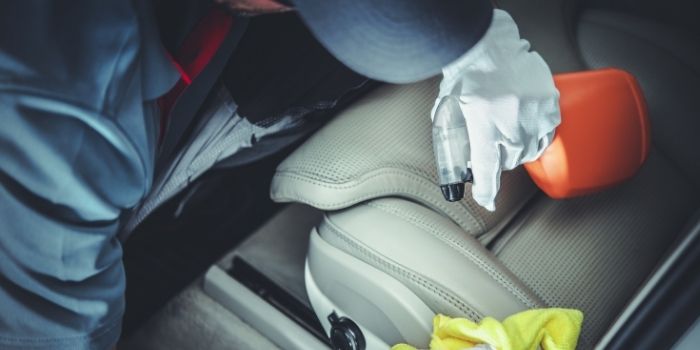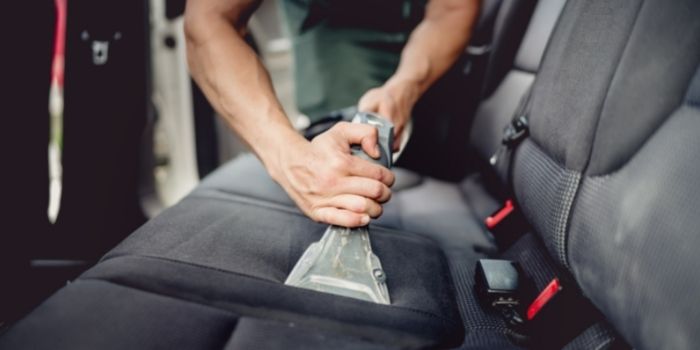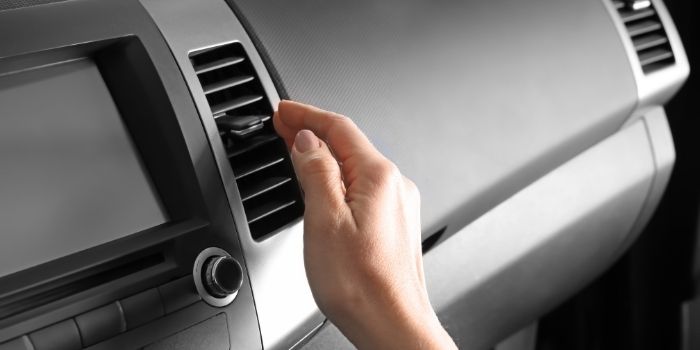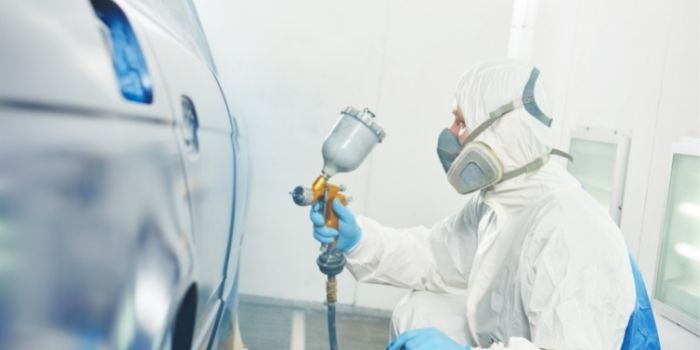There’s nothing quite like the sinking feeling of spotting a burn hole in your pristine leather car seat.
Whether it’s from a rogue cigarette, a drop of hot food, or that brief “oops” moment with a curling iron, burns are among the most annoying interior damages.
Unlike a scratch or spill, a burn doesn’t just stain—it eats into the surface, leaving behind an ugly crater that mocks you every time you open the door of your car or a mobile home.
But here’s the good news: you don’t need to call a professional or trade your ride in just yet. With the right tools, techniques, and a bit of patience, you can repair burn holes in leather or fabric upholstery at home—and make them nearly invisible.
Let’s break down how to fix burn marks step-by-step, how to deal with discoloration, and what it means for your car’s resale value.
Repairing a Cigarette Burn in a Car Seat
Cigarette burns are the most common type of small leather seat damage. They start as a small charred hole but can worsen if not fixed quickly—especially if moisture or friction gets into it.
Whether it’s leather, vinyl upholstery, or fabric, here’s a step-by-step process on how you can tackle it yourself.
Step 1: Inspect and clean the burn area
Before doing anything, gently vacuum around the damaged spot. You don’t want ash, dirt, or loose fibers interfering with the repair.
Then, wipe the area with a mild leather cleaner or rubbing alcohol. This helps remove oils and debris so the repair materials adhere properly.
Pro Tip: If you’re dealing with a burn hole in a cloth car seat, a fabric cleaner works better than a leather one.
Step 2: Trim away the charred edges
Use a sharp razor blade or small scissors to carefully remove the burnt or melted leather edges.
You’re aiming for clean, solid material around the hole. Don’t enlarge the damage—just remove the blackened or crusty bits.
This step is crucial because any loose charred residue will prevent the repair compound or patch from sticking evenly.
Step 3: Fill the hole (leather and vinyl seats)
If it’s a small burn (less than a dime), you can fill it using a leather repair kit. These usually include a filler compound that mimics the texture of leather or vinyl upholstery.
- Apply a small amount of filler using a palette knife or plastic spreader.
- Smooth it evenly and let it dry for 20–30 minutes.
- Repeat if needed until it’s level with the seat surface.
If the burn is deeper, you might need a sub-patch. Cut a small piece of leather from a hidden area (like under the seat) or use a repair patch. Insert it under the hole to act as a backing, then apply the filler over it.
For fabric upholstery: Use fabric glue and a small piece of matching cloth under the burn. Let it dry completely before blending the texture.
Step 4: Rebuild the surface texture
Once the filler is dry, gently sand it with fine-grit sandpaper (around 600–800 grit) to match the texture of the surrounding seat.
Some repair kits come with texturing paper—a genius tool that helps mimic the leather grain pattern. Place it over the repaired area, apply gentle heat with a heat gun (low setting), and press lightly.
Step 5: Color matching and dye application
This is where the magic happens. Use a leather dye or colorant that matches your seat. Many kits come with customizable colors.
Mix and test it on a hidden area first (like the inside of a car’s door panel).
- Apply the color using a sponge or cotton swab.
- Let it dry, then apply a second coat if needed.
- Once you’re happy with the match, seal it with a leather finish for protection.
Step 6: Blend and buff
After the final layer dries, buff the surface lightly with a soft cloth. This removes excess residue and gives it a consistent sheen with the surrounding area.
If it’s vinyl upholstery, apply a vinyl protectant for that subtle factory-fresh gloss.
Step 7: Condition and protect
Finish by conditioning the entire seat using a high-quality leather conditioner. This helps even out the color and keeps the leather supple.
Bonus Tip: Regular conditioning also prevents future burns from spreading, cracking, or deepening.
Can I use super glue instead of fabric glue for a burn hole?
No. Super glue hardens and becomes brittle, which can crack or damage your seat further. Always use fabric glue or leather adhesive designed for upholstery repairs.
How can I tell if my car seat is real leather or vinyl upholstery?
Touch and smell are your best indicators. Real leather feels warm and textured, while vinyl is smoother and slightly plasticky.
Also, leather absorbs moisture; vinyl repels it. You can also check the manufacturer’s label inside the car’s door.
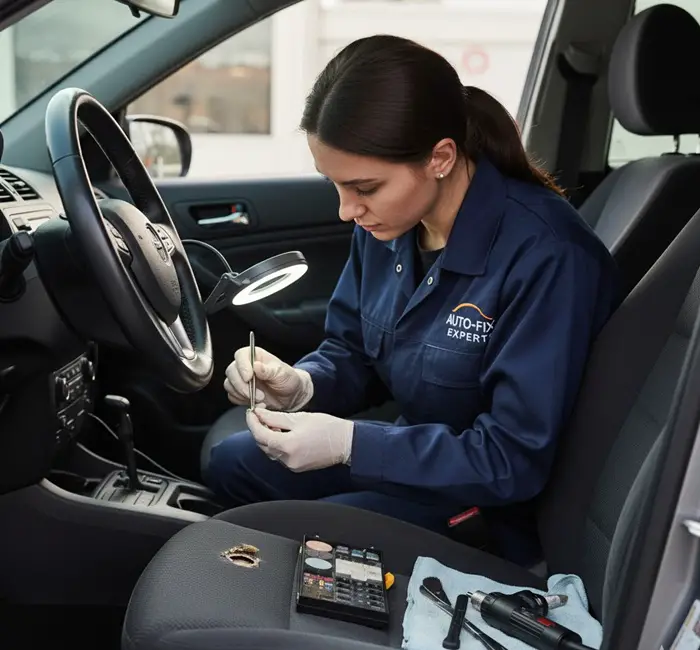
Do Burn Marks Fade Over Time?
Sadly, no. Burn marks don’t magically fade with time—especially on leather or vinyl surfaces. In fact, they often stand out more as the surrounding leather fades naturally from sun exposure.
However, you can visually minimize discoloration and surface scars with the following tricks:
- Use a leather recoloring balm: These are tinted creams that blend minor discoloration. They work best for small surface burns.
- Apply a thin layer of shoe polish or leather wax: Match the color and buff gently to camouflage the burn.
- Use repair alcohol or specialized blending solution: This can even out shiny vs dull patches after a repair. (Yes, you can repair alcohol burs on car interiors too—just test first!)
- Heat blending method: For light scuffs or discoloration from hot food, lightly heat the surface using a hair dryer and gently massage with conditioner.
Example: If you’re wondering what should you do if hot food burns your leather car seats, wipe immediately, cool the area with a damp cloth, and later use a mild conditioner or repair balm to reduce marks.
These steps won’t erase deep burns, but they can disguise minor discoloration beautifully.
Can Mirrors in the Car Burn Car Seats?
Yes—surprisingly, they can!
If you’ve ever left a compact mirror or reflective ornament on your dashboard, it can act like a magnifying glass under direct sunlight. The concentrated beam can actually burn or discolor your seat surface—especially leather or vinyl.
Here’s what happens:
- Sunlight passes through or reflects off the mirror at just the right angle.
- The focused heat scorches a pinpoint area on the seat.
- The result looks like a cigarette burn but with smoother, melted edges.
Prevention Tips:
- Avoid leaving mirrors, glass perfume bottles, or metallic accessories inside your car.
- Use windshield shades and park in shaded areas.
- Keep seat covers if your car spends long hours under the sun.
How Much Does it Cost to Repair a Car Seat Burn?
If you’re doing it yourself, DIY kits are surprisingly affordable:
| Type of Material | DIY Repair Cost | Professional Repair Cost |
|---|---|---|
| Leather Upholstery | $20 – $40 | $100 – $250 |
| Vinyl Upholstery | $15 – $35 | $80 – $200 |
| Fabric Upholstery | $10 – $25 | $70 – $150 |
If the damage covers a large area, professional shops may charge per inch or per seat section.
For example, a full seat panel replacement can run anywhere from $300 to $700, depending on the car model and material quality.
Tip: Some car dealerships outsource this work, so you can often get it done at body or upholstery shops for less.
Will a Cigarette Burn in My Car Bring Down Its Value – How Much?
Absolutely—it can.
Even a tiny burn hole spot in my car can raise red flags for potential buyers or dealerships.
Small burns suggest neglect or smoking habits, both of which can knock $200–$500 off your car’s resale value, depending on its age and model.
If the damage is large or visible on premium leather, it could drop the perceived value by up to 5%.
Used car buyers tend to overestimate the cost of fixing these flaws, so a small DIY repair can literally pay for itself when selling or trading in your car.
Related FAQs
Can I use nail polish remover to clean burn marks in a car?
Avoid it! Acetone in nail polish remover can strip leather dye and worsen discoloration. Stick with isopropyl alcohol or mild soap-based cleaners.
Will repairing a burn in a car seat void any warranty or insurance?
Usually not. But if your car is under manufacturer warranty, check the fine print—some only cover defects, not user damage. DIY repairs generally don’t affect insurance unless the burn resulted from a covered incident like a car fire.
What’s the best way to repair a cigarette burn hole in car upholstery if it’s fabric, not leather?
For fabric seats, trim the burned fibers, apply fabric glue, and fill the hole with matching fibers (from under the seat or a hidden area). Let it dry, then brush gently to blend.
Final Thoughts
Burn holes in your car seats might feel like permanent battle scars, but they don’t have to be. With the right tools, patience, and technique, you can restore your car’s interior to near-original condition—and save hundreds of dollars in the process.
Whether you’re patching up a cigarette burn, fixing a melted spot from hot food, or disguising discoloration from sunlight or mirrors, the key is to act fast and use the right materials.
DIY kits today are incredibly user-friendly and can make even serious burns almost invisible. And if you’re selling or trading in your car, those few minutes of careful repair could mean hundreds more in your pocket.
So the next time you notice that tiny flaw on your seat, don’t stress—grab your fabric glue, your repair kit, and a little patience. Your leather throne will be back to luxury status before you know it.

Based in Orem (Utah) John Paterson graduated from Utah Valley University and has begun writing in 2009. He has a large wealth of experience in writing articles related to cars, automotive repair, wheels, cleaning/maintenance, and much more. He has also written instructional articles in a similar niche for a few online publications as well. Currently, he works as a mechanic in his personal garage shop where he loves serving his countrymen from his heart.

